Readers of this blog will be familiar with many ways to “game” the Aeroplan loyalty scheme. I’ve already discussed some killer strategies that you can use to squeeze every drop of value out of your Aeroplan miles, such as maximizing stopovers, combining two trips into one redemption, leveraging long layovers, finding the MPM online, avoiding fuel surcharges, and nesting trips.
True mastery of a points program, though, involves being able to draw upon a multitude of “tricks and secrets”, using them to your advantage at a moment’s notice. Today I’m sharing with you 9 incredibly useful things to know about Aeroplan, which can help you drastically lower your award travel costs in terms of both cash and miles. Some of these things certainly don’t seem like they were intentionally designed this way…
Before we start, make sure you’ve read the Guide to Aeroplan and the series on the Aeroplan Mini-RTW, so that you’re familiar with things like stopovers, layovers, and MPMs.
In This Post
- 1. Don’t Trust the Search Engine
- 2. Upgrading a Mixed Cabin Segment for Free
- 3. Maximize Your Schedule Change
- 4. Getting On Revenue Flights
- 5. Share Your Super Elite Privileges
- 6. Share Your Aeroplan Diamond Privileges
- Conclusion
1. Don’t Trust the Search Engine
This is the easy one, which I’d hope most of you already knew.
The Aeroplan search engine is notoriously unreliable. As a rule of thumb, you should always assume that the search engine is acting against your best interests.
For example, if a Montreal–Athens redemption is possible on any of Air Canada, Lufthansa (both of which levy carrier surcharges), and Turkish Airlines (which does not), the search engine will most likely “forget” to show you the option to fly on Turkish.
After all, we all know that carrier-imposed surcharges are little more than a shameless cash grab on the part of the airlines, so it makes sense why Aeroplan would design their search engine in this anti-consumer fashion.
What’s the solution? Make sure to search for availability on United.com or using a service like ExpertFlyer as well, to catch any possibility that Aeroplan happens to “forget”.
In addition, familiarize yourself with Star Alliance route networks by using a website like FlightConnections.com – in our example, if you searched Montreal–Istanbul and then Istanbul–Athens separately, you’d be able to piece together the availability and then call in to book.
2. Upgrading a Mixed Cabin Segment for Free
This is a handy one to keep in mind. Often times when you redeem Aeroplan miles for, say, a trip in business class, you end up having to make do with a segment or two in economy class, since that was the only space available on a particular flight at the time.
If business class space later opens up on that flight, you can call in and upgrade your economy seats to business for free! In the below itinerary, for example, if business class space later opens up on the exact same Toronto–Boston flight, you can request the upgrade for no extra charge.
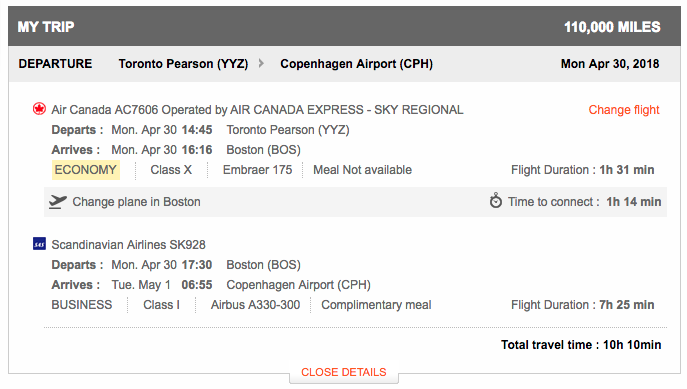
There’s no change fee as long as it’s the same flight as before, and you’ve already paid the amount of miles for the higher class of service. The same idea holds for upgrading a segment from economy or business class to First Class, if you’ve paid the miles for a First Class redemption.
3. Maximize Your Schedule Change
It can definitely be frustrating when airline changes up the schedule for your already booked flight. But it can also be a blessing in disguise.
You see, once a ticket has been affected by a major schedule change (this usually means a change of at least one hour, so those annoying five-minute adjustments to flight times unfortunately don’t count), you’re allowed to request all sorts of changes for free. It gets even more fun if your schedule change results in your itinerary truly conking out – like arriving at a certain airport a couple of hours after your next flight has already departed.
The typical allowance I hear from Aeroplan supervisors is that you can change to any routing that you’d like within three days of the original flight date. You also won’t have to pay any change fees, airport taxes, or – that’s right – carrier-imposed surcharges!
Of course, you still need to find available award space, but taking advantage of a schedule change can be an excellent way to fly products like Lufthansa First Class or Austrian business class without getting fleeced by carrier-imposed surcharges.
4. Getting On Revenue Flights
I mentioned above that when reissuing your ticket after a schedule change, you still need to look for available award space. But what if there’s simply no space available?
Well, Aeroplan still has an obligation to get you from one point to another, based on the contract you established at the time you purchased your ticket (unless Uncle Swiss has something to say about it, of course). So if there’s truly no award space available, Aeroplan is obliged to go out there and buy you revenue flights in order to hold up its end of the deal.
It’s not unheard of for Aeroplan to purchase full-fare business class seats on Star Alliance flights when schedule changes can’t be resolved within the award space ecosystem. Passengers can then credit these flights to any Star Alliance points program (including Aeroplan itself) and earn redeemable miles!
Of course, this isn’t something you can willingly control, but you bet that whenever you notice a schedule change on your Aeroplan award, your instinct should be to figure out how you can best leverage this to your advantage.
5. Share Your Super Elite Privileges
I’ve mentioned this on the blog before, but one of the nifty tricks with Aeroplan is how easily one member can extend their privileges to another.
For example, Air Canada Super Elite members can enjoy a full waiver of the carrier-imposed surcharges when redeeming miles for Air Canada flights. By booking trips out of a Super Elite friend’s account, you can literally save thousands of dollars on some Air Canada routes, and you can enjoy the convenience of nonstop flights from Canada to your destination as well.
Tricks like these is why I think networking is so important in the game these days. But of course, Super Elite members are few and far between. It’s a good thing their privileges aren’t the only ones for which “sharing is caring”…
6. Share Your Aeroplan Diamond Privileges
Aeroplan Diamond status is by all accounts easier to attain than Air Canada Super Elite. Load $100/day on three AC Conversion cards and you’re there.
Just like Super Elite privileges, you can bestow your Aeroplan Diamond privileges on other members as well. For starters, you can book Market Fares for others at the heavily discounted rate.
What some people might not realize is that the other big perk of Diamond status – lower change and cancellation fees – is also extendable.
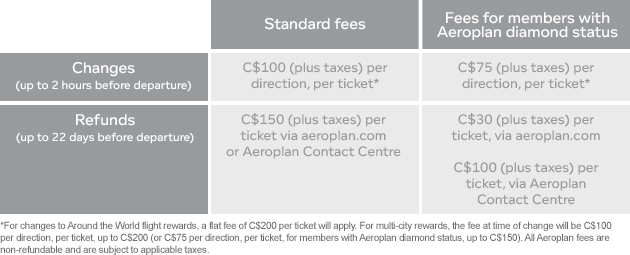
If you, as a Diamond member, phone up the Aeroplan call centre and enter your Aeroplan number, you’re able to make changes to any itinerary – no matter which account the miles originally came out of – for the Diamond change fees. So, if you haven’t earned Diamond status, it’s time to make friends with someone who has!
Conclusion
Aeroplan has helped countless Canadians unlock the world, and that’s just within the boundaries of its flight reward chart. Once you get into all the juicy tricks and secrets, the value you can get from Aeroplan can only get even higher. I hope that you find some of these useful, and that they get your mind thinking of ways to find even more secrets hidden within Aeroplan!













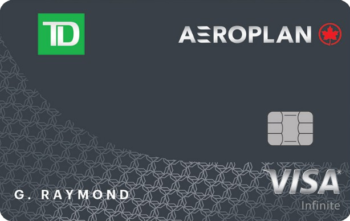


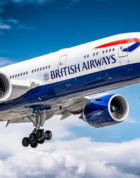

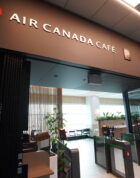

Hello,
How do you check if there is any business seats available release? Do I need to check all the times, they are seats available if booking with cash but not with areoplan points, is there any chances they will be released last minute? Does the mixed class get automatic upgrade or I have to call in? is there any chance for UA release business seats ? I booked SFO-PEK-SIN class I but now the flight is cancelled , I check only flight available is economy from SFO-NRT (12 hours flight !!!) on UA, there is a lot of bus seats available on UA booking site though. Do you think I have a chance to upgrade it ? Thank You
Hey Ricky, how do you go about doing #2? Any way to know when to call in to ask for the upgrade?
I recently found an mixed cabin itinerary(multi city) where it’s economy/prem Econ on leg 1, then business on leg 2, and economy on leg 3 for 75K (YEG – BRU – YUL – YEG) but then on booking, it bumps to 110K. Is there no way to have a business class segment within the 75K redemption?
I am looking at nrt sin syd and the first leg is on sq in economy. Is there hopes of getting a J seat that would open up?
Yep, SQ is decent with regional business class availability, so there’s always a chance.
Even on the a380?
YUL-ZRH, ZRH-DXB, DXB-IST is 8573 miles according to gcmap and using your mpm trick, YUL-IST has a mpm of 7929.
I suppose could start at a slightly further location (ex. LAX) and book a separate aeroplan positioning flight for 12,500 which would still represent a savings of 12,500. Perhaps not as far as LAX is necessary
How does #7 tip works in terms of luggage? It always sent to the final destination with only the States as an exception where you have to pick up your luggage for the customs.
Either don’t check bags or schedule an overnight layover at your "jumping-off point" so that it’s reasonable for you to ask the bags to be short-checked instead of being sent all the way through.
Hiya, does anyone know if I would be able to book PEK-TYO-PVG in business for 25000 miles?
I’m waiting to book YVR/LHR one way for next August 8th. At what time of the day do they add the next day? Currently it’s up to Aug.4…sometime tonight Aug.5 will be available…at what time does this happen?
Thanks.
How? Aeroplan Diamond status is by all accounts easier to attain than Air Canada Super Elite. Load $100/day on three AC Conversion cards and you’re there.
Thanks
Unfortunately this trick doesn’t work anymore, since the AC Conversion Card stopped allowing CAD reloads back in April.
Hey Ricky,
Great tips, thank you.
Any advice on booking Avianca flights? Any idea why Aeroplan is blocking them?
Bruce
There seems to be issues with Aeroplan reservations on Avianca getting ticketed successfully. Unfortunately there’s no telling when the issue will be fixed. We can only take heart from the fact that similar issues on Swiss, Air China, and Copa were all fixed recently, and hope that Avianca comes back sooner rather than later.
Hey for #1. How do I figure out how much it will cost me for a flight on ex. United? Do I just call Aeroplan or is there a way to actually see it on the website? I’m looking at YVR to LHR for June 8th to June 22nd.
To find out how many miles your award will cost, use the Aeroplan Reward Chart, located at https://www.aeroplan.com/use-your-miles/flight-rewards-chart
Hi Ricky I am trying to do the hidden city redemption as above Montreal – Istanbul via Dubai. Is this an itinerary that I have to piece together and call in to aeroplan to book because I cant find anything with Dubai enroute to Instanbul! Appreciate if you can explain how to do this booking so I can hop out in Dubai!
Thank you as always!
Marlene
Yes, the Aeroplan search engine isn’t gonna show you anything via Dubai. You have to find space for Montreal-Zurich, Zurich-Dubai, and then Dubai-Istanbul separately and then call in to Aeroplan to piece it all together.
Another great and useful post, Ricky! Thanks for sharing.
Wondering what restrictions I might face while building connections <24h on an itinerary like this one:
I am looking at YHZ-SIN, which has a MPM of 15153 mi. My itinerary would look like this (all within the MPM):
YHZ-SIN (destination) SIN-NRT (stopover) NRT-CDG (stopover) CDG-YHZ.
Am I able to connect in DPS on my way to SIN? DPS is located further from YHZ than SIN is, so I am worried DPS would be considered my destination instead of SIN.
You can do a layover in DPS without changing the destination. If you do a stopover in DPS, DPS will become the destination since it’s further away.
Is there a way to use my Kriesflyer mile to fly for YYZ-YVR?
Thanks
For #8, is that a one way itinerary? If so, does that mean I can have as many layovers (<24hrs) as I want on a one way trip as long as I’m within my MPM?
Yes!
Great reading and as usual fantastic information
Ricky omit everything I just said! Not sure why I was looking for a 30,000 redemption when you cleary said it would be 37,000! Whoops! Sorry!
Cheers,
Marlene
Hello again Ricky and thank you for all of the great information that you provide for all of us! Im having trouble finding Vancouver -Istanbul for 30,000 redemption. It comes up 37,500 for me. I tried using multi city Vvr-pek- ist but that didnt work either. What am I missing please. Also can I get to Dubai from Vancouver for 30,000 redemption. Im thinking i would redeem 30,000 to cross the pond and then catch a cheap flight to Nairobi from there! Preferably from Dubai as the flights are cheapest from there. Would appreciate some assistance with this as Im obviously missing something! ????
Boom!
Awesome Post, thanks a bunch Ricky!
A quick question though about availability on Aeroplan’s search engine. I’ve asked this question on fourms previously and been told "no". Regarding your comments on seeing more availability on United’s MilagePlus, am I able to call into Aeroplan at the time of my booking and spoon feed the agent the segments showing up on MilagePlus when they’re no where to be seen on Aeroplan? What about for airlines that Aeroplan is so obviously blocking, like LOT & Adria Airways ? Thank You!
Yes you should be able to spoon feed the flights to the Aeroplan agent, providing it’s on Star Alliance and not an airline like Aer Lingus that partners only with United but not Aeroplan.
I haven’t heard about Aeroplan blocking LOT and Adria award space; in fact I was able to able to book an Adria award just last month. In any case the agents should be able to see the award space. The only airline I’m aware that Aeroplan is actively blocking at this moment is Avianca.
Can I ask what dates you’re using as an example to see any availability from LOT or Adria? There have been numerous posts about at least LOT availability totally 100% disappearing from Aeroplan. I have gone from April-Aug looking for a single flight from Warsaw to anywhere on LOT and Aeroplan will not show it. They pretty well force you to connect in Austria using Austrian so they can scam charge you
For Adria, LJU-SVO on Feb 26 shows space in both economy and business.
For LOT you may have a point. A call to Aeroplan should clear up whether there are any “communication issues” at this moment with LOT, causing the flights to be blocked (similar to what happened with Air China, Copa, and Swiss). I might call to ask as well; if I do, I’ll let you know.
Ricky,
When was the last time you actually called into Aeroplan to spoon feed them an itinerary not showing on their search engine.
I just did this for a valid mileage plus itinerary but the answer was "sorry, we only see the same search results as you see
Thanks
Probably last week or so. Occasionally you run into an obtuse agent who refuses to accept being spoon-fed, so you just have to hang up and call again.
Also looking for some clarity on point 5. Great post!
Loss of useful information as always!! Excellent work…. Just wanted to know how does #5 works…
If I know someone who has elite status, how can the person help in waiving the charges? Points are in my account so not sure how that trick works.
Thanks
It’s easy to transfer your Amex MR miles to your friend’s Aeroplan account. Once you’ve done that, get the friend to book a ticket for you out of their own account. Job done!
How do you change the Aeroplan account info once it’s been set with MR?
Incredibly helpful. Thanks so much for posting this!